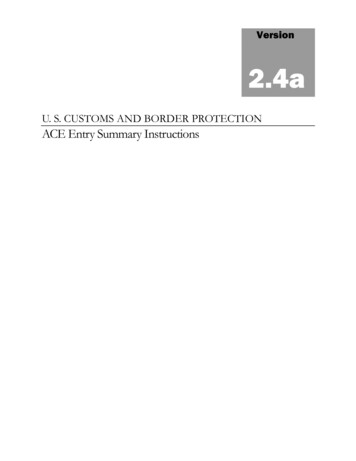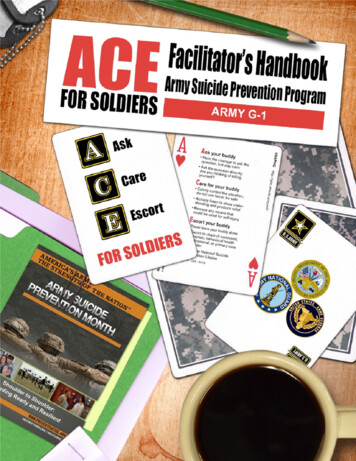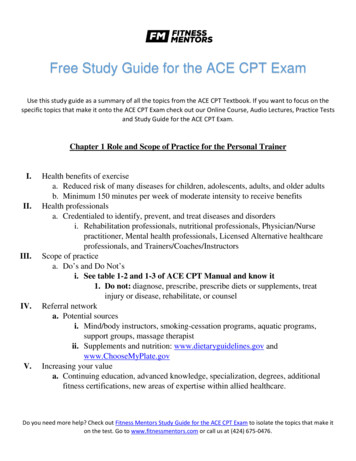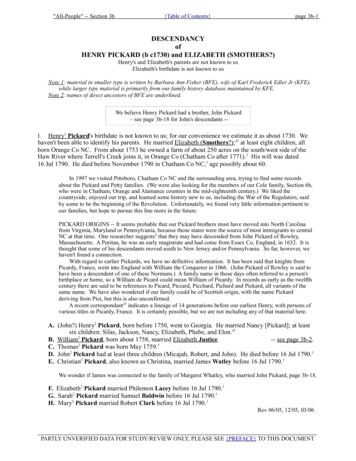
Transcription
EDUCATORs’ Guide forELIZABETH ACEVEDO’sIncludes discussion questions and educator resources for readingand discussing Elizabeth Acevedo’s novels in verse with teen readers.HarperStacks.com
Clap When You LandABOUT THE BOOKCamino Rios loves the water, her tía, her island, and spending every summer with her papiwhen he visits her in the Dominican Republic. Yahaira Rios lives in New York City and idolizesher father but has recently had a hard time looking him in the face. When they both receivethe news that their father’s plane has crashed, they know that their lives will never be the same.Just like that, these two girls are thrown into a reality where their father is dead and it seemstheir dreams are quickly slipping away. How do you cope with losing the father you love whilereckoning with the secrets he kept from you? What will it mean to be a sister to someoneyou’ve never met? And what will Camino and Yahaira do to keep their dreams alive?DISCUSSION QUESTIONSSISTERHOOD The author writes the first part of the book switching between the sisters’ points of view in each chapter. In the lastsection of the book, however, their perspectives are combined, and we often have to figure out who is speaking bycontext clues. Why do you think the author chose to structure the book in this way? How does your understandingof the sisters change when you start seeing them through each other’s perspective? Camino and Yahaira both have complicated feelings about suddenly having a sibling. What are some examples oftheir conflicting feelings in the text? How do these feelings change over time? Both Camino and Yahaira have close, trusting relationships with other female friends, family, and/or girlfriends. Whatare some moments in the book where women show up, protect, and care for one another? How do Camino andYahaira define sisterhood? How do these views change throughout the book? What is sisterhood to you?GRIEF & LOSS What are some of the ways that Camino and Yahaira describe the way they feel after losing their father? What arethe similarities and differences in how the sisters grieve for their father while trying to understand him? How doestheir grief change over time and throughout the book? The plane crash in this book does not impact only Camino and Yahaira. How does the island react when Camino’spapi passes? How is Yahaira’s neighborhood affected by the crash? How are Dominican people everywhere affected? “My father was the one who always threw the get-togethers, & even in death, he brings us all home” (pg. 134).How does their father’s death bring everyone “home”? How can death bring people together, both literally andfiguratively? How can death and grieving change relationships between the people who are left behind? How is thisshown in the book?M I S O G Y N Y & D I S C R I M I N AT I O N What does Yahaira mean when she says “in the real world I am not treated as a lady or a queen, as a defender oropponent but as a girl so many want to strike off the board” (pg. 94)? How are Yahaira and Camino treated asdisposable by the men in this novel? How are they controlled by men? How does the way you see yourself differfrom who the world believes you to be? What do you do when those two things don’t match up? What makes Yahaira feel like her body is not her body? (pg. 176) How does this experience change Yahaira’s feelingsabout winning her chess tournament? How do Tia’s assumptions about El Cero’s attention (pg. 155) affect Camino?What silences both sisters when they want to talk with the adults in their lives about what’s happening to them?
The Poet XABOUT THE BOOKXiomara Batista feels unheard and unable to hide in her Harlem neighborhood. Ever since herbody grew into curves, she has learned to let her fists and her fierceness do the talking. ButXiomara has plenty she wants to say, and she pours all her frustration and passion onto thepages of a leather notebook, reciting the words to herself like prayers—especially after shecatches feelings for a boy in her bio class named Aman, who her family can never know about.With Mami’s determination to force her daughter to obey the laws of the church, Xiomaraunderstands that her thoughts are best kept to herself. When she is invited to join her school’sslam poetry club, she knows that she could never get around Mami’s rules to attend, muchless speak her words out loud. But still, she can’t stop thinking about performing her poems.Because in the face of a world that may not want to hear her, Xiomara refuses to be silent.DISCUSSION QUESTIONSSILENCE How does Xiomara reckon with her own silence? Have you ever felt silenced? Why or why not? How did you work toovercome this silence? What do you think “holding a poem in the body” means? Do you think you have words living inside of you? Whatwords are they? What are the rules, implicit and explicit, that Xiomara identifies her mother having for her? Are they different fromrules her mother sets for other people? Why or why not? What rules do you live by? How does Xiomara feel about her brother being gay? How does she think her silence affects Twin? Have you everstayed silent and wished you hadn’t? How can you speak up in your own life? How does silence protect Xiomara? How does Xiomara’s silence harm the people she is closest to? How do her wordsfree her? Reflect on times in your own life when silence has protected you or someone else. Now, think about timeswhen silence has harmed you or others. Does the intent always match the impact?B R AV E R Y What is it about writing that makes Xiomara feel brave? What makes you feel brave? How can you use an activity orcreative outlet to inspire bravery in yourself or in others? Discuss the different ways that art can be brave. How does Xiomara’s relationship with writing change her relationship with her mother over the course of the novel?Why do you think her writing affects her relationship with her mother? What about the church and spirituality—howdoes X compare and contrast religious expression and poetry?VO I C E Why does Xiomara feel as though “[her] words are okay” when she is in Ms. Galiano’s class but not when she is withother people or in other places (pg. 264)? Do you have places where your words feel more safe and places wherethey feel less safe? What makes a person or a place feel safe? How can you create safety in a place where it might belacking? Have you ever heard a poem or song or watched a movie that made you feel seen? What is it about that particularpiece of art that affected you in that way? Are there ways in which you can use your voice to make others aroundyou feel seen? How can you show others they’ve been heard? Why does Xiomara call poetry club a prayer circle? Do you think that writing can be healing? Do you think art canbe healing? How can different artistic expressions work to heal various wounds?
THE POET X A N D CLAP WHEN YOU LANDJOINT DISCUSSION QUESTIONS C lap When You Land is based on real events that took place. How can poetry and fiction be used to access,understand, and highlight history and social events? Find poems in Clap When You Land and The Poet X where there are intentional spaces left between the words.What do this these spaces between words on the page—called caesuras—do for the reader? Why do you think theauthor chose to arrange the poems like this? How does the structure of a poem change the way you read, hear, orunderstand a story? Find poems in both novels that have repeating phrases, words, or lines. What is the purpose of this repetition?What is it meant to emphasize? How does it make you feel? Read it aloud. Does the repetition make you read itdifferently? In Clap When You Land, the poem on pg. 184 can be read both horizontally and vertically. What does thismultidirectional writing do to the way you read a poem? What purpose does it serve? What does it highlight? In both The Poet X and Clap When You Land, Acevedo uses the list poem format to explore different concepts. Wherecan you find examples of this in the text? What is the difference between a list and a list poem? What do you thinkmakes a poem a poem? In Clap When You Land, Acevedo shares a portion of dialogue between the two sisters, putting the work on the readerto identify who’s talking through placement and context (pgs. 338-339). Acevedo does a similar thing in The PoetX. Can you find other instances of this kind of dialogue in both texts? How does this formatting change the way youengage with the text?WRITING PROMPTS “I know what ugly looks like when it departs from your mouth fully formed. How the words can push space betweentwo people; how it’s close to impossible to collapse that space.” (Clap When You Land, pg. 304). What words haveyou said or have been said to you that have created space between you and someone else? Write those words down.Now, find the opposites of each word. What words could collapse those spaces? Yahaira often understands the world through the rules of chess, and Camino says she feels most herself when sheis in the water. These are perspectives that their father instilled in them and they are metaphors that shape theirstories. What is a metaphor? What is one of your metaphors for understanding the world? Who gifted it to you?Where did you learn it? Write a poem exploring those personal metaphors and answering the question: What haveyou inherited that has shaped who you are now? Think about how Acevedo’s characters feel about their dreams and aspirations. Why do some of them feel like theirdreams are impossible to achieve? How does that impact their emotions and interactions with others? What are yourdreams? Write a list poem outlining the steps you need to take to meet those dreams. Choose one of Xiomara’s poems in The Poet X. What is the structure of the poem? What poetic devices is she using?(repetition, rhyme, onomatopoeia, metaphor, praise, haiku, etc.)? Write your own poem using the same poeticdevice and/or structure found in the poem you chose. Choose any of Ms. Galiano’s assignments in The Poet X. Write your own answer in response. What do you stay silent about that maybe you shouldn’t? Multiple characters in Clap When You Land grapple withsecrets and silence. The Poet X’s Xiomara has a lot of secrets she keeps to herself that she only reveals in poetry.What is one thing you wish more people knew about you that you haven’t been able to say?
Teaching Novels in VerseWhat is a novel in verse?Simultaneously novel and poem, a verse novel is a narrative that uses the rhythm, imagery, and style of poetry todevelop characters, make meaning, and tell a story within the structure of a novel. Because it bridges the borders ofmany forms, it is able to provide several points of access for different kinds of learners and readers.Why teach novels in verse?1. They are genre-defying books that employ aspects of dialogue, monologue, and screenwriting, as well as the literarydevices most often found in poetry, to tell a story. Because of this, they are great texts to study the different waysauthors use format and genre in their writing.2. O ften, verse novels use more figurative language than traditional novels, providing a bounty of examples of differentliterary devices to explore with students like simile, metaphor, and personification.3. Verse novels provide engaging, emotionally resonant pathways into larger discussions centered around the humanities,social studies, and the sciences. They also provide short and powerful sections of text to explore with students workingon their language skills.4. Each passage encapsulates a complete concept within the larger story, providing bite-size entry points for readers tounderstand and engage with the main ideas of the text without having to read an entire chapter.5. They provide an entryway to poetry for those who may struggle with more abstract concepts, since the poems in averse novel are often character driven and thusly anchored. Additionally, they provide accessible narratives by utilizingmore white space on each page, which in turn makes struggling readers feel less daunted by the amount of text.6. A verse novel is often a collage of brief moments of action, emotional depth, or character reflection. This storytellingstructure requires readers to more actively interact with the text by piecing these moments together like a puzzle tounderstand the whole, enhancing their critical-thinking skills.7. P oetry is a visual art form that, in part, expresses meaning through the ways the author chooses to place words on apage. The graphic nature of poetry engages visual learners and makes abstract ideas concrete. This varied placement ofwords in each poem provides more visual excitement for reluctant readers.8. A uditory learners are more deeply engaged by the musicality of poetic language, the pacing of dialogue, the linebreaks, and the creative punctuation that lend themselves to orality and classroom read-alouds.Tips for using verse novels with studentsEncourage both concrete and abstract thinking Ask: What’s happening physically? What’s happening emotionally or metaphorically?Use the text to center students’ lived experiences Don’t look for any one “right” answer; rather, encourage student interpretations and inference.Don’t forget the author Ask: Why do you think they made the choices they did?Promote active engagement with the text Encourage discussion between students, critical-thinking exercises, and learning activities to develop a deeperunderstanding of content.
Teaching Novels in Verse(CONTINUED)Extension ActivitiesCollectively explore character development Using Venn diagrams, list the commonalities between characters from Acevedo’s novels. Now, list theirdissimilarities. What characteristics and experiences connect them? What sets them apart from one another? Choose examples from Clap When You Land and have students read different passages aloud as the different sisters.Ask the rest of the class to guess the narrator of each passage.Encourage imaginative speculation and literary analysis Ask students to choose a passage or “model poem.” Analyze the voice and literarydevices utilized. Then ask them to write their own poems mimicking the style ofwriting in that passage. First, through reflective writing and then in small groups, ask students to imaginewhat they think might happen next in the story line of their choice and to createalternate story lines within their groups. Emphasize that it is not about beingright or getting the closest to what actually happens next but about reflecting onwhat they know of the characters, being imaginative, and using clues in the text(foreshadowing) to anticipate what might be possible.Address key concepts and ideas Choose several different poems that explore the books by theme.Move students into groups and ask them to read and discusspassages that explore the key concepts or main ideas in thetext. Ask: What stood out to you about the passage?What is the main concept being expressed?How does it connect to the rest of thebook?About Elizabeth AcevedoELIZABETH ACEVEDO is the author of The Poet X—which won the National BookAward for Young People’s Literature, the Michael L. Printz Award, the Pura BelpréAward, the Boston Globe–Horn Book Award, and the Walter Award—as well as Withthe Fire on High and Clap When You Land. She is a National Poetry Slam championand holds an MFA in creative writing from the University of Maryland. Acevedo liveswith her partner in Washington, DC. You can find out more about her atwww.acevedowrites.com.Guide prepared by Amanda Torres (www.amandatorreswrites.com), writer, community organizer, educator, and non-profit consultant.Elizabeth Acevedo photo by Denzel Golatt.
Camino Rios loves the water, her tía, her island, and spending every summer with her papi when he visits her in the Dominican Republic. Yahaira Rios lives in New York City and idolizes her father but has recently had a hard time looking him in the face. When they both receive











